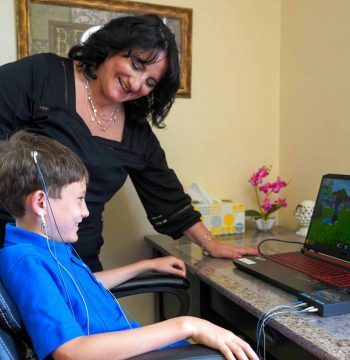Measurable Energy Therapies Improve CNS Function
People often assume that energy medicine therapies are hard to quantify, but some can be measured and proven scientifically. PEMF, biofeedback and neurofeedback are quantifiable scientific therapies backed by brainwave training research. These are still viewed as unconventional, however, because instead of depending on chemistry, brainwave training is a therapy that focuses on energy or physics to heal.
We are primarily energetic beings. The brain is a complex organ that is made up of billions of brain cells called neurons. In order for our brains to work, these neurons communicate with each other using electricity. The combination of millions of neurons sending signals at once produces an enormous amount of electrical activity in the brain. Sensitive medical equipment, such as an EEG, can measure electricity levels over areas of the scalp.
This dynamic, interconnected web of biological energy is impacted by everything in our environment. Neurofeedback provides brainwave training to our system; it focuses on our central nervous system, which directly improves the brain’s ability to self-regulate. Without self-regulation, disorders of the central nervous system (CNS) can result in anxiety, depression, headaches and other conditions. Neurofeedback directly alters brainwave function.
Electrical activity emanating from the brain is displayed in the form of brainwaves. We have different brainwaves that vary based on their frequency, ranging from the low activity to high activity (delta, theta, alpha and beta). Everyone has the same brainwaves, but people do not have the same pattern and levels of brainwaves. Certain patterns are associated with specific conditions.
Most people are born with a relatively healthy nervous system and regulated brainwave function. Genetic and environmental factors—such as diet, stress and external environment influences—can impact brain wave functioning and the CNS. This lack of self-regulation can lead to a variety of symptoms, including lack of focus, anxiety, mood issues and physical symptoms. Dysregulation reflects either an under-responsive, over-responsive or unstable nervous system.
Engineered brainwave training—such as neurofeedback—uses the simple concept of reinforcement to improve regulation of the brain and CNS. This brainwave-training therapy gives visual and auditory reinforcements to help the brain change its own behavior as a form of associative learning. In neurofeedback, the associative learning is learning to perceive the feeling of the signal. By creating new electrical activity through a process of measurement and reinforcement, the brain learns to self-regulate, which calms the nervous system. This reduces or eliminates symptoms.
Neurofeedback has been used to treat ADHD, autism, anxiety, PTSD/trauma, OCD, tic disorders, stress, emotional distress, behavioral or mood issues, chronic pain, neurocognitive and neuropsychiatric issues associated with Lyme and PANS/PANDAS, headaches/migraines, concussions and a variety of other issues. Almost any brain—regardless of its level of function or dysfunction—can be trained to function better. Neurofeedback can be used with all ages.
ADHD often means that a person has too many slow brainwaves frontally—at theta, or a lower frequency—and not enough fast, higher frequency beta brainwaves. This brainwave imbalance makes it hard to stay focused in non-preferred areas because the brain is bored. This is why decreasing theta brainwave and increasing beta brainwave training can help people with ADHD.
There are more than 3,000 peer-reviewed brainwave training research studies spanning four decades that demonstrate its effectiveness (Lubar & Shouse, 1976). Current research supports that neurofeedback improves a variety of specific issues and symptoms, from seizures to ADHD and anxiety.
Recent meta-analyses document the effectiveness of neurofeedback in the treatment of ADHD (Arns, de Ridder, Strehl, Breteler and Coenen, 2009) in reducing inattention, impulsivity and hyperactivity. Research from Gani et al. (2008) demonstrates the long-term effectiveness of neurofeedback, as they found that improvements in behavior and attention were stable six months and two years after completion of therapy.
Neurofeedback produces lasting changes that puts people on a path to wellness, and improves brain functioning and mental health. It works synergistically with other therapies as it focuses on regulating the CNS, which can reduce symptoms simultaneously.
Neurofeedback requires time and energy commitment, as teaching the brain to change often requires therapy two times a week over several months. The easy process consists of patients receiving reinforcement while watching a movie in a comfortable chair. For most, symptoms gradually decrease, while for others, change can be dramatic depending on symptoms or root issues.
Individuals with CNS dysregulation should consider effective, safe and research-based therapies that work with the body’s own rhythm, such as neurofeedback, biofeedback and PEMF. Tapping into the body’s own frequencies can help reduce stress; improve sleep, mood and attention; increase processing speed; decrease pain or discomfort; and create feelings of wellness.
Always remember… “Calm Brain, Happy Family™”
Are you looking for SOLUTIONS for your struggling child or teen?
Dr. Roseann and her team are all about solutions, so you are in the right place!
There are 3 ways to work with Dr. Roseann:
You can get her books for parents and professionals, including: It’s Gonna Be OK™: Proven Ways to Improve Your Child’s Mental Health, Teletherapy Toolkit™ and Brain Under Attack: A Resource For Parents and Caregivers of Children With PANS, PANDAS, and Autoimmune Encephalopathy.
If you are a business or organization that needs proactive guidance to support employee mental health or an organization looking for a brand representative, check out Dr. Roseann’s media page and professional speaking page to see how we can work together.
Dr. Roseann is a Children’s Mental Health Expert and Therapist who has been featured in/on hundreds of media outlets including, CBS, NBC, FOX News, PIX11 NYC, The New York Times, The Washington Post,, Business Insider, USA Today, CNET, Marth Stewart, and PARENTS. FORBES called her, “A thought leader in children’s mental health.”

She is the founder and director of The Global Institute of Children’s Mental Health and Dr. Roseann Capanna-Hodge. Dr. Roseann is a Board Certified Neurofeedback (BCN) Practitioner, a Board Member of the Northeast Region Biofeedback Society (NRBS), Certified Integrative Medicine Mental Health Provider (CMHIMP) and an Amen Clinic Certified Brain Health Coach. She is also a member of The International Lyme Disease and Associated Disease Society (ILADS), The American Psychological Association (APA), Anxiety and Depression Association of America (ADAA) National Association of School Psychologists (NASP), International OCD Foundation (IOCDF) International Society for Neurofeedback and Research (ISNR) and The Association of Applied Psychophysiology and Biofeedback (AAPB).
© Roseann-Capanna-Hodge, LLC 2023
Disclaimer: This article is not intended to give health advice and it is recommended to consult with a physician before beginning any new wellness regime. *The effectiveness of diagnosis and treatment vary by patient and condition. Dr. Roseann Capanna-Hodge, LLC does not guarantee certain results.













